I approached these figures with a considerable amount of trepidation for a
number of reasons.. first the figures (by Newline designs) are very very nice
and deserve a certain amount of skilled paint brush'ery, but two, one of the
main drivers for my interest in the American Civil War was to be able to have
a couple of zouave regiments present! So much responsibility to rest on such
tiny metal shoulders
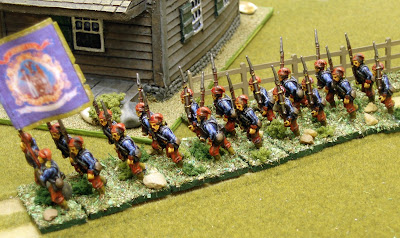 Either way can I present you with the first of the two zouave regiments (one
Confederate and one Union) to join my American Civil War project; these are
the Union 5th New York Volunteer Infantry, better known as "Duryée's Zouaves"
after their first colonel, Colonel Abram Duryée.
Either way can I present you with the first of the two zouave regiments (one
Confederate and one Union) to join my American Civil War project; these are
the Union 5th New York Volunteer Infantry, better known as "Duryée's Zouaves"
after their first colonel, Colonel Abram Duryée.
The regiment was formed on April 12th, 1861, by a group of military enthusiasts in Manhattan, was formally accepted by the state on April 23rd. It deployed to Fort Schuyler at Throgs Neck, New
York Harbour to organise, and was mustered into the United States army to
serve for two years on May 9th. It must have been a sight to see; "the
majority of the soldiers were educated and above average height".
by the state on April 23rd. It deployed to Fort Schuyler at Throgs Neck, New
York Harbour to organise, and was mustered into the United States army to
serve for two years on May 9th. It must have been a sight to see; "the
majority of the soldiers were educated and above average height".
Colonel Abram Duryée was appointed as the commander of the regiment (that's him to the left - an interesting man, he came from a family of soldiers, made general in the Union army, as did his son, and after the war he became New York City Police Commissioner!).
On the 23rd May it embarked for Fortress Monroe, camped for a few days near Hampton Bridge, then moved to Camp Butler, Newport News, and was attached to Brig Gen Ebenezer W. Peirce's brigade.
The troops of the 5th led the force at the battle of Big Bethel (June 10, 1861; the 5th New York Zouaves attempted to turn the Confederate left flank, but were repulsed) and lost 5 killed, 16 wounded and 2 missing.
In July they would be transferred to US Major General John A Dix’s division. Garrisoned in Baltimore, they would serve in the city’s defences through March 1862 when they were transferred to Brigadier General George Sykes’ Second Division of US Major General Fitz John Porter’s V Corps – Army of the Potomac - with which it fought in the battles of the campaign on the Peninsula. McClellan said that "the Fifth is the best disciplined and soldierly regiment in the Army." During this period Duryée had been promoted to general rank, so Governeur Kemble Warren (now that's a name..) took over command of the regiment.
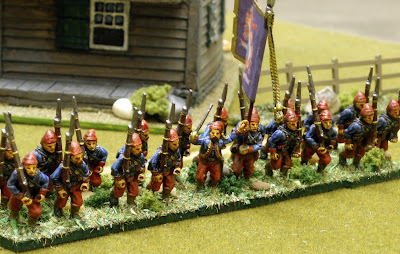 At the Battle of Hanover Courthouse on May 27th the regiment played only a
minor role. However, they had a more major role in the Seven Days Battles
(June 25th –July 1st, 1862; a series of battles that prevented the Union army
capturing Richmond - 'Bobby' Lee forced McClellan back to the James River)
At the Battle of Hanover Courthouse on May 27th the regiment played only a
minor role. However, they had a more major role in the Seven Days Battles
(June 25th –July 1st, 1862; a series of battles that prevented the Union army
capturing Richmond - 'Bobby' Lee forced McClellan back to the James River)
As McClellan moved his base to the James River on June 27, 1862, the regiment fought against the Confederate soldiers under Gregg’s South Carolina brigade. In a counter-attack, the regiment defeated the initial Rebel attack.
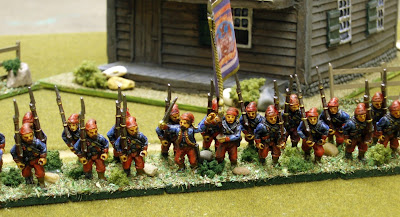 In August 1862, the regiment came under the command of General John Pope. At
the Second Battle of Manassas (also known as the Second Battle of Bull Run),
the 5th New York Volunteer Infantry regiment was forced to withstand the
advancing forces of General James Longstreet. After the hard fighting of the
Seven Days battles, the regiment numbered around 560 men – 60 of which were
new recruits.
In August 1862, the regiment came under the command of General John Pope. At
the Second Battle of Manassas (also known as the Second Battle of Bull Run),
the 5th New York Volunteer Infantry regiment was forced to withstand the
advancing forces of General James Longstreet. After the hard fighting of the
Seven Days battles, the regiment numbered around 560 men – 60 of which were
new recruits.
Pope seriously underestimated the size of the Confederate advance and ordered the regiment to support Hazlett’s Battery. The stage was set for their bravest and most tragic moment.....
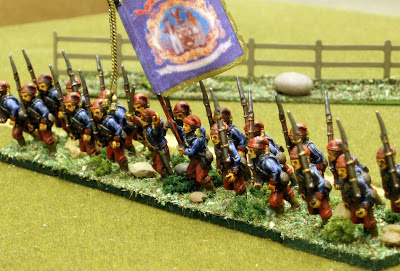 Longstreet’s soldiers easily outnumbered the small regiment, and the Texas
Brigade (a battle hardened group that included the 1st, 4th and 5th Texas
regiments, the 18th Georgia and the Hampton South Carolina Legion - four or
five regiments to one!) quickly inflicted over 330 casualties on the regiment.
One hundred and twenty of the zouaves were killed within
eight minutes (!), the greatest single
battle attrition of all Federal volunteer infantry regiments in the entire
Civil War. The entire colour guard was killed, except for one man. The only
officer to survive the battle was Captain Cleveland Winslow (who went on to
command the regiment - though it would seem the men didn't particularly like
him as he was a bit of a martinet).
Longstreet’s soldiers easily outnumbered the small regiment, and the Texas
Brigade (a battle hardened group that included the 1st, 4th and 5th Texas
regiments, the 18th Georgia and the Hampton South Carolina Legion - four or
five regiments to one!) quickly inflicted over 330 casualties on the regiment.
One hundred and twenty of the zouaves were killed within
eight minutes (!), the greatest single
battle attrition of all Federal volunteer infantry regiments in the entire
Civil War. The entire colour guard was killed, except for one man. The only
officer to survive the battle was Captain Cleveland Winslow (who went on to
command the regiment - though it would seem the men didn't particularly like
him as he was a bit of a martinet).
"Forced to retreat towards Henry House Hill, nearly a mile to their rear,
the few remaining Zouaves gathered around the regimental flag, which
Warren had ordered jabbed into the ground. As Hennessy described in his
authoritative narrative on Second Manassas, 'Warren sat immobile on his
horse, looking back as if paralysed, while a handful of his men, formed in
files of four, blackened with dust and smoke, stood under the colours as
silent as statues, gazing vacantly….A murmur of surprise and horror passed
through the ranks of our Regulars at the fate of this brave regiment.'
With only sixty of its men filing under the regimental flag on Henry Hill,
five hundred lay scattered - dead, wounded or missing - on the stubble
field one mile to the west. The scene of slaughter was not missed by the
charging Confederates, with one of Hood’s men stating the scene was 'a
ghastly, horrifying spectacle.'"
Later, at the Battle of Antietam on September 17th, not surprisingly, what was left of the regiment was held in reserve.
 Three months later they fought at Fredericksburg, and on December 15 helped
cover the Federal retreat from the town.
Three months later they fought at Fredericksburg, and on December 15 helped
cover the Federal retreat from the town.
Following several months in winter quarters, Winslow (who was now colonel) led the Zouaves in their final campaign culminating in the Union defeat at Chancellorsville (the Confederate victory was tempered somewhat by the mortal wounding of "Stonewall" Jackson to friendly fire, a loss that Lee likened to "losing my right arm.").
"The officers and men of the Fifth New York behaved as they have always done," brigade commander Patrick O'Rorke reported; "I can give them no higher praise."
On May 14, 1863, the regiment, commanded by Winslow, was honourably discharged and mustered out of service. Its three years' men (the newer recruits still with time to serve) were transferred to the 146th New York Volunteer Infantry.
During its service the regiment lost by death, killed in action, 4 officers, 126 enlisted men; of wounds received in action, 2 officers, 47 enlisted men; of disease and other causes, 37 enlisted men; total, 6 officers, 210 enlisted men; aggregate, 216.
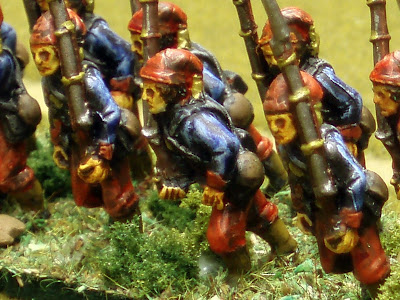 Figures are Newline Designs, 20mm, and painted largely with inks - Winsor
& Newton calligraphy ink (blues and blacks), and Daler Rowney FW acrylic
ink for the red (nicer shade than the Winsor & Newton equivalent)..
Figures are Newline Designs, 20mm, and painted largely with inks - Winsor
& Newton calligraphy ink (blues and blacks), and Daler Rowney FW acrylic
ink for the red (nicer shade than the Winsor & Newton equivalent)..
======================================
At some point in time this week I noticed that the number of visitors to the site snuck past the 100,000 mark - only one word for it, "blimey"... oh, and all of you need to get out more!
 Either way can I present you with the first of the two zouave regiments (one
Confederate and one Union) to join my American Civil War project; these are
the Union 5th New York Volunteer Infantry, better known as "Duryée's Zouaves"
after their first colonel, Colonel Abram Duryée.
Either way can I present you with the first of the two zouave regiments (one
Confederate and one Union) to join my American Civil War project; these are
the Union 5th New York Volunteer Infantry, better known as "Duryée's Zouaves"
after their first colonel, Colonel Abram Duryée.The regiment was formed on April 12th, 1861, by a group of military enthusiasts in Manhattan, was formally accepted
Colonel Abram Duryée was appointed as the commander of the regiment (that's him to the left - an interesting man, he came from a family of soldiers, made general in the Union army, as did his son, and after the war he became New York City Police Commissioner!).
On the 23rd May it embarked for Fortress Monroe, camped for a few days near Hampton Bridge, then moved to Camp Butler, Newport News, and was attached to Brig Gen Ebenezer W. Peirce's brigade.
The troops of the 5th led the force at the battle of Big Bethel (June 10, 1861; the 5th New York Zouaves attempted to turn the Confederate left flank, but were repulsed) and lost 5 killed, 16 wounded and 2 missing.
In July they would be transferred to US Major General John A Dix’s division. Garrisoned in Baltimore, they would serve in the city’s defences through March 1862 when they were transferred to Brigadier General George Sykes’ Second Division of US Major General Fitz John Porter’s V Corps – Army of the Potomac - with which it fought in the battles of the campaign on the Peninsula. McClellan said that "the Fifth is the best disciplined and soldierly regiment in the Army." During this period Duryée had been promoted to general rank, so Governeur Kemble Warren (now that's a name..) took over command of the regiment.
 At the Battle of Hanover Courthouse on May 27th the regiment played only a
minor role. However, they had a more major role in the Seven Days Battles
(June 25th –July 1st, 1862; a series of battles that prevented the Union army
capturing Richmond - 'Bobby' Lee forced McClellan back to the James River)
At the Battle of Hanover Courthouse on May 27th the regiment played only a
minor role. However, they had a more major role in the Seven Days Battles
(June 25th –July 1st, 1862; a series of battles that prevented the Union army
capturing Richmond - 'Bobby' Lee forced McClellan back to the James River)As McClellan moved his base to the James River on June 27, 1862, the regiment fought against the Confederate soldiers under Gregg’s South Carolina brigade. In a counter-attack, the regiment defeated the initial Rebel attack.
 In August 1862, the regiment came under the command of General John Pope. At
the Second Battle of Manassas (also known as the Second Battle of Bull Run),
the 5th New York Volunteer Infantry regiment was forced to withstand the
advancing forces of General James Longstreet. After the hard fighting of the
Seven Days battles, the regiment numbered around 560 men – 60 of which were
new recruits.
In August 1862, the regiment came under the command of General John Pope. At
the Second Battle of Manassas (also known as the Second Battle of Bull Run),
the 5th New York Volunteer Infantry regiment was forced to withstand the
advancing forces of General James Longstreet. After the hard fighting of the
Seven Days battles, the regiment numbered around 560 men – 60 of which were
new recruits. Pope seriously underestimated the size of the Confederate advance and ordered the regiment to support Hazlett’s Battery. The stage was set for their bravest and most tragic moment.....
 Longstreet’s soldiers easily outnumbered the small regiment, and the Texas
Brigade (a battle hardened group that included the 1st, 4th and 5th Texas
regiments, the 18th Georgia and the Hampton South Carolina Legion - four or
five regiments to one!) quickly inflicted over 330 casualties on the regiment.
One hundred and twenty of the zouaves were killed within
eight minutes (!), the greatest single
battle attrition of all Federal volunteer infantry regiments in the entire
Civil War. The entire colour guard was killed, except for one man. The only
officer to survive the battle was Captain Cleveland Winslow (who went on to
command the regiment - though it would seem the men didn't particularly like
him as he was a bit of a martinet).
Longstreet’s soldiers easily outnumbered the small regiment, and the Texas
Brigade (a battle hardened group that included the 1st, 4th and 5th Texas
regiments, the 18th Georgia and the Hampton South Carolina Legion - four or
five regiments to one!) quickly inflicted over 330 casualties on the regiment.
One hundred and twenty of the zouaves were killed within
eight minutes (!), the greatest single
battle attrition of all Federal volunteer infantry regiments in the entire
Civil War. The entire colour guard was killed, except for one man. The only
officer to survive the battle was Captain Cleveland Winslow (who went on to
command the regiment - though it would seem the men didn't particularly like
him as he was a bit of a martinet).Later, at the Battle of Antietam on September 17th, not surprisingly, what was left of the regiment was held in reserve.
Following several months in winter quarters, Winslow (who was now colonel) led the Zouaves in their final campaign culminating in the Union defeat at Chancellorsville (the Confederate victory was tempered somewhat by the mortal wounding of "Stonewall" Jackson to friendly fire, a loss that Lee likened to "losing my right arm.").
"The officers and men of the Fifth New York behaved as they have always done," brigade commander Patrick O'Rorke reported; "I can give them no higher praise."
On May 14, 1863, the regiment, commanded by Winslow, was honourably discharged and mustered out of service. Its three years' men (the newer recruits still with time to serve) were transferred to the 146th New York Volunteer Infantry.
During its service the regiment lost by death, killed in action, 4 officers, 126 enlisted men; of wounds received in action, 2 officers, 47 enlisted men; of disease and other causes, 37 enlisted men; total, 6 officers, 210 enlisted men; aggregate, 216.
 Figures are Newline Designs, 20mm, and painted largely with inks - Winsor
& Newton calligraphy ink (blues and blacks), and Daler Rowney FW acrylic
ink for the red (nicer shade than the Winsor & Newton equivalent)..
Figures are Newline Designs, 20mm, and painted largely with inks - Winsor
& Newton calligraphy ink (blues and blacks), and Daler Rowney FW acrylic
ink for the red (nicer shade than the Winsor & Newton equivalent)..At some point in time this week I noticed that the number of visitors to the site snuck past the 100,000 mark - only one word for it, "blimey"... oh, and all of you need to get out more!
Zoauves must be the only readson to get into the ACW as a wargame period. So much colour amongst the blue and grey.
ReplyDeleteAnd you've done such justice to them. Bravo!
Agreed! Lovely 'inking' work there. You almost make me want to try some inks. . . for reds especially.
ReplyDeleteBest Regards,
Stokes
Fine looking lads, worthy successors.
ReplyDeleteAre those Louisiana Tigers I see far off in the distance?
Ross
Very nice paint job and I really enjoyed reading your unit history. I also think the Louisiana Tigers must be next up!
ReplyDeleteSteve
ReplyDeleteHave you ant recommendations for figs to use as iron brigade?
Cheers
Mel
Thanks chaps - much appreciated...
ReplyDeleteStokes - I recommend the inks wholeheartedly as a very quick way of introducing shading and depth with just one coat - don't forget to undercoat black, and then dampbrush white, so as to give the ink a base...
Striker/Ross Mac - Tigers? You'd think so wouldn't you.. :o) As it happens though I think not - the Tiger zouaves were only one company ; on fact most of the Confederate zouvaves were only company strength - just one regimental sized unit, so they're the one's I plan to paint... a virtual beer to the first person who gets the name...
My apologies Prince Henry - in 20mm I have no idea - Newline do exclusively every variation of coat and marching pose - but only with Kepi or Slouch Hat - no Hardee's...
Steve,
ReplyDeleteI am a bit confused by comparing the 2nd Manassas with their total casualties for the whole two years . . . they seem to contradict each other.
But the unit looks quite good, sir.
-- Jeff
Jeff - good spot... I hadn't noticed. Guess that's the problem with using multiple sources, that clearly contradict each other! :o))
ReplyDelete